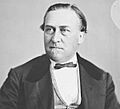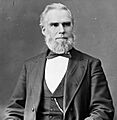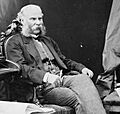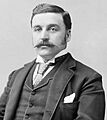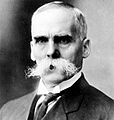Minister of Crown–Indigenous Relations and Northern Affairs facts for kids
Quick facts for kids Minister of Crown–Indigenous Relations |
|
|---|---|
|
Incumbent
Rebecca Alty since May 13, 2025 |
|
| Crown–Indigenous Relations and Northern Affairs Canada | |
| Style | The Honourable |
| Member of | |
| Reports to |
|
| Appointer | Monarch (represented by the governor general)
on the advice of the prime minister
|
| Term length | At His Majesty's pleasure |
| Inaugural holder | Hector Louis Langevin |
| Formation | May 22, 1868 |
| Salary | CA$299,900 (2024) |
The Minister of Crown–Indigenous Relations is a special member of the Canadian Cabinet. This person's main job is to work with the Indigenous peoples of Canada, which include First Nations, Métis, and Inuit communities.
This minister leads a government department called Crown–Indigenous Relations and Northern Affairs Canada (CIRNAC). This department is in charge of important laws like the Indian Act. It also works on building a better relationship between the Canadian government and Indigenous peoples.
The role was created in 2017 by Prime Minister Justin Trudeau. He split the old department for Indigenous affairs into two new ones. This created the Minister of Crown–Indigenous Relations and a separate Minister of Indigenous Services. The goal was to focus more on relationships and treaties, while the other minister handles services like healthcare and water for Indigenous communities.
Contents
What Does This Minister Do?
The main goal of the Minister of Crown–Indigenous Relations is to improve the relationship between the Canadian government (often called "the Crown") and Indigenous peoples. This is sometimes called a "nation-to-nation" relationship.
According to the government, the minister's job includes:
- Renewing the relationship between Canada and First Nations, Inuit, and Métis peoples.
- Changing government structures to help Indigenous communities become more self-governing.
- Leading the government's work in Canada's North.
This means working on treaties, land claims, and supporting Indigenous peoples' rights to make their own decisions.
Important Words and Ideas
Over the years, the words used to describe Indigenous peoples have changed.
- Indian: This is an older term. It is still used in historical and legal documents like the Indian Act and the Canadian Constitution. Some people find this word offensive today.
- First Nation: This term became popular in the 1970s. It is often used to refer to Indigenous peoples in Canada who are not Métis or Inuit.
- Aboriginal or Indigenous: These words are used to describe all three groups together: First Nations, Inuit, and Métis. "Indigenous" is the term most commonly used today.
The idea of an "Aboriginal nation" is also important. It refers to a large group of Indigenous people who share a history, language, culture, and live in a specific territory.
History of the Role
The relationship between the Canadian government and Indigenous peoples has a long history. The job of managing this relationship has changed many times since Canada was formed in 1867.
Early Years (1867–1966)
Before 1867, the British government's Indian Department handled relations with Indigenous peoples. After Canada was created, a "Superintendent-General of Indian Affairs" was put in charge. For a long time, this job was even held by Canada's first prime minister, Sir John A. Macdonald.
Over the next few decades, the responsibility was passed between different government departments. For a while, it was part of the department for mining, and later, the department for immigration.
A New Department (1966–2017)
In 1966, the government created the position of Minister of Indian Affairs and Northern Development. This combined the responsibility for Indigenous peoples with the management of Canada's northern territories.
For many years, there were calls to change the relationship. In 1983, a report called the Penner Report suggested getting rid of the Indian Act and giving Indigenous communities more power to govern themselves. However, these changes did not happen at the time.
More reports, like the Royal Commission on Aboriginal Peoples (1996) and the Truth and Reconciliation Commission of Canada (2015), also called for major changes. They said that government policies needed to respect Indigenous rights and the United Nations Declaration on the Rights of Indigenous Peoples.
Splitting the Role (2017–Present)
In 2017, Prime Minister Justin Trudeau announced a big change. The old department of Indigenous and Northern Affairs would be split into two. This created the Minister of Crown–Indigenous Relations and the Minister of Indigenous Services.
The idea was to have one minister focus on the big picture of rights, treaties, and self-government. The other minister would focus on providing better services to communities. For a time, the roles were combined again, but they are now separate.
List of Ministers
Many people have held this important job over the years. The title of the minister has changed several times. Here are some of the people who have served in this role.
| No. | Portrait | Name | Term of office | Political party | Ministry | |
|---|---|---|---|---|---|---|
| Minister of Indigenous and Northern Affairs | ||||||
| 55 |  |
Carolyn Bennett | November 4, 2015 | August 28, 2017 | Liberal | 29 (J. Trudeau) |
| Minister of Crown–Indigenous Relations and Northern Affairs | ||||||
| (55) |  |
Carolyn Bennett | August 28, 2017 | July 18, 2018 | Liberal | 29 (J. Trudeau) |
| Minister of Crown–Indigenous Relations | ||||||
| (55) |  |
Carolyn Bennett | July 18, 2018 | October 26, 2021 | Liberal | 29 (J. Trudeau) |
| 56 |  |
Marc Miller | October 26, 2021 | July 26, 2023 | Liberal | |
| 57 | Gary Anandasangaree | July 26, 2023 | December 20, 2024 | Liberal | ||
| Minister of Crown–Indigenous Relations and Northern Affairs | ||||||
| (57) | Gary Anandasangaree | December 20, 2024 | March 14, 2025 | Liberal | 29 (J. Trudeau) | |
| March 14, 2025 | May 13, 2025 | 30 (Carney) | ||||
| Minister of Crown–Indigenous Relations | ||||||
| 58 | Rebecca Alty | May 13, 2025 | present | Liberal | 30 (Carney) | |
See also
- Minister of Indigenous Services
- The Canadian Crown and First Nations, Inuit and Métis
- Aboriginal peoples in Canada
Images for kids


